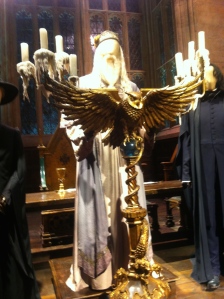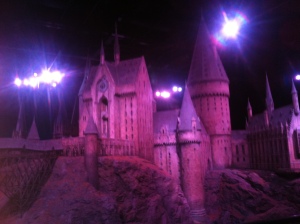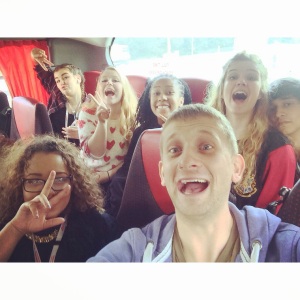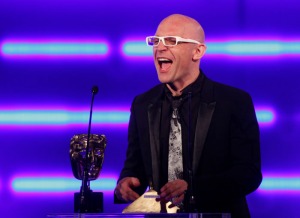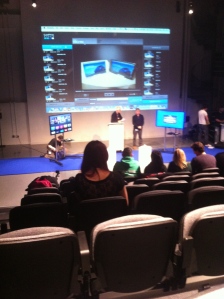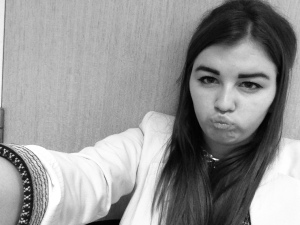Introduction
I will be examining various Audience Theories and analysing how they have been used in the past, what they suggest and also their effectiveness alongside real-life examples. I will be focusing on the Reception Theory, Hypodermic Needle Theory and the User and Gratifications Theory.
Hypodermic Needle Theory – Example: Orson Welles War of the Worlds Reading
Theories are merely an idea; some have more proof than others. Evidence is crucial to making something a fact or a theory, but the terms are often blurred. The Hypodermic Needle theory is an idea that suggests audiences are passive and thus absorb and copy ideas and opinions presented to them through media. This theory suggests that people have no choice to subconciously take in information given to them and therefore the theory is known to focus and be identified in areas of negativity- for example Grand Theft Auto- a video game aged 18 plus that has allegedly been a motivation or stimulus behind criminal activity all over the world. The idea is that information given can influence elements peoples lives and choices they make on a daily basis.
Promotional campaigns and charities influence people to make choices, and insinuate negative ideas to influence donations etc; for example:

An environmental campaign used this image of a polar bear to suggest that his habitat was melting and he would die without living on ice- they forgot to mention that actually, polar bears have the ability to swim in deep water, and are known in zoos and also the wild for doing so; which proves that the insinuation made is a huge hyperbole. Another media example would be the television series The Big Bang Theory- a programme that many people may believe and relate to. Several of the ideas shared throughout include suggestions that; ‘all scientists are nerds’, ‘alcohol is needed to talk to women’ (as one character Raaj cannot talk to women without having a drink first, which may encourage audience members to drink), Aspergers syndrome is humorous (A main character Sheldon suffers with the condition and his OCD is a laughing stock in the show), social anxiety is a lighthearted problem, and the list goes on.
Overall, the theory suggests that everyone is the same, and audiences naively copy behaviour of people in the media, as they are passive and just wish to learn and talk about stories and elements of the media amongst peers.
In 1927, Harold Laswell, an american political scientist published a book named ‘Propaganda Technique in the World War’ and spoke about the idea that “industrious men injected into the veins of staggering people, until the smashing powers of allied armies knocked them into submission’. The idea is that vulnerable people are targeted and influenced by media forced towards them. The Hypodermic Needle Theory suggests that mass media has a extremely powerful and direct effect on the audience it aims to target. It is a long-running theory first developed in the 1920’s that has been used several times on mass scale throughout the years. Mass media in the 1940s and 1950s were perceived as an extremely powerful influence on behaviour change at the time, here are several examples from between the 20’s and now:
- Hitler’s monopolization of the mass media during WWII to unify the German public behind the Nazi party, using newspapers, posters and videos to dominate the media and ‘brainwash’ the public.
- The War of the Worlds broadcast in 1938 by Orson Welles, causing thousands of people to believe that America was being invaded by aliens, using a simple dramatic reading over radio broadcast: https://www.youtube.com/watch?v=Xs0K4ApWl4g
As shown in the first example, the theory itself has it’s negatives, and can often be used in a negative way. If an audience member is rational and dissects every piece of information fed to them through the media then they would not be affected by the theory. Unfortunately, the theory is a much like gossip, and if you are compelled enough to listen to it and take in the information, then you are likely to believe it and live by it- Or so the theory suggests.
User and Gratifications Theory – Example: Geordie Shore (MTV Reality TV Show)
This theory differs slightly from that of the hypodermic needle. This theory suggests that audiences are active and use media for specific reasons, meaning that they usually get a positive experience from using media foreducational, leisure and entertainment purposes. People can also use the media as an escapism from the real world, but not everyone absorbs it like a sponge (as suggested with the hypodermic needle ideology).
 An audience can use media tosocially interact with friends and peers on platforms such as online gaming, that feature party chat and 2 player mode etc. This is alongside people being able to relate to certain aspects and characters portrayed through the media.A character example for this theory would be Effy from Skins, as personally, I could relate in some senses to her frustration of the world, and at one point idealised her lifestyle. In comparison, The Big Bang theory compared in this light would be positive; reflecting a positive outlook on the world through the use of colourful and lighthearted mis en sen and the issues throughout are all handled in a lighthearted manner. It could also be seen as educational, and it is humorous- therefore entertaining. To summarise, the key reasons this theory suggests an audience uses the media in short are:
An audience can use media tosocially interact with friends and peers on platforms such as online gaming, that feature party chat and 2 player mode etc. This is alongside people being able to relate to certain aspects and characters portrayed through the media.A character example for this theory would be Effy from Skins, as personally, I could relate in some senses to her frustration of the world, and at one point idealised her lifestyle. In comparison, The Big Bang theory compared in this light would be positive; reflecting a positive outlook on the world through the use of colourful and lighthearted mis en sen and the issues throughout are all handled in a lighthearted manner. It could also be seen as educational, and it is humorous- therefore entertaining. To summarise, the key reasons this theory suggests an audience uses the media in short are:
- to identify
- to socially interact
- to be educated
- to be entertained
- to escape reality (escapism)
Paul Lazarsfeld was a pioneering social researcher famous in the 1920’s for his ideas surrounding the User and Gratifications theory- then called the ‘Limited Effects Theory’. In the Oxford Dictionary of Media and Communication (2011), Lazarfeld’s ideolody was mentioned: ‘Lazarsfeld’s conclusion from survey research in the 1940s stated that, contrary to popular assumptions, the mass media cannot directly change most people’s strongly-held attitudes or opinions. This is usually explained in relation to selective perception: viewers tend to select and interpret media messages in accordance with their existing attitudes and beliefs, and their use of the mass media tends to reinforce these. The limited effects view was later confirmed by Hovland, who demonstrated the importance of many intervening variables.’
A perfect example in which the User and Gratifications theory exists would be the MTV series Geordie Shore, based on the real lives of young people in Newcastle. This theory insinuates that audiences use television and film as an escapism; and the show reflects the idea of this theory due to it’s crazy themes and idillic party lifestyle that an audience may desire and enjoy learning about. It is an extremely popular show with audiences between the ages of 16-25, and consequently, social media also plays a huge part in the shows success. The theory is also reflected in this exampleas the audience can interact with the stars, and follow their lifestyle as they watch their rise to fame. Here are an example of two of the stars’ Twitter profiles, where you can see they have a mass following fan base that creates a further buzz about the show. 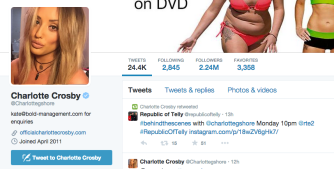
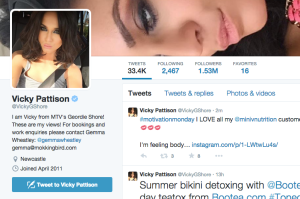
The show is a combination of entertainment, education and an insight, into the lives of this niche group of people that live such a hectic and somewhat unhealthy lifestyle. This, somehow is a lifestyle the audience of the target age often desire, and enjoy learning about. Again, the programme is a talking point not only among social media, but is also popular through word of mouth… This means that fans of the show in the audience category will discuss controversial topics brought up in the show, and compare opinions; this relates back to the theory. The idea of the theory is that people converse about the lifestyle portrayed throughout, which in turn, creates a larger buzz about the show, therefore making more people want to watch it. Here is the show’s trailer for it’s sixth season, which idolises a party life in Australia. This may be a feature that could influence the audience.
One negative point of the theory, especially with this example is that television shows such as Geordie Shore, can set a bad example for younger audiences watching the programme, as it encourages casual sex, excessive alcohol consumption and unhealthy lifestyles. It glamourises the idea of a lifestyle that is unrealistic and dangerous, and the stars are looked up to as role models by young people- which isn’t exactly suitable. The theory is positive in the way that it encourages people to converse and share ideas about the media they see, making it a social boost for a wide audience.
Reception Theory – Example: Drugs Live (Channel 4)
There are three responses that can be expected when the reception theory occurs surrounding a television programme, and Channel 4’s ‘Drugs Live’ provoked all three of it’s factors from various audiences. Preferred responsecan occur when the media effects someone in a way which the creator aimed them to, a rejected response is the opposite. A negotiated response is the main thing the reception theory highlights; where the audience sees both sides and has both reactions, and weighs up pro’s and con’s or ‘negotiates’ with the media product. An alternative example would be a McDonalds advert; a preferred response would be someone sees it and wants to buy the product, a rejected response would mean they would not want to and would think of the background issues, and a negotiated response would mean that someone sees the issues and still craves the product, and has to decide from that viewpoint.
the creator aimed them to, a rejected response is the opposite. A negotiated response is the main thing the reception theory highlights; where the audience sees both sides and has both reactions, and weighs up pro’s and con’s or ‘negotiates’ with the media product. An alternative example would be a McDonalds advert; a preferred response would be someone sees it and wants to buy the product, a rejected response would mean they would not want to and would think of the background issues, and a negotiated response would mean that someone sees the issues and still craves the product, and has to decide from that viewpoint.
The Reception Theory is a version of the reader-response theory that was originally used to indicate a specific readers response to a literary text. In Literature, it originated from the work of Hans-Robert Jauss (A german academic, famous in the 1960’s for his recognition of the reception theory as it were). In the 1970’s, a man named Stuart Hall from the University of Birmingham, developed a new ideology to depict the theory. He recognised the way that producers effectively ‘encoded’ information into a media product, for an audience to then later ‘decode’ it. He was the first to identify the idea of the preferred, negotiated and rejective responses.
The example programme I have chosen, was based on the controversial topic of the illegal class B drug marijuana; and Channel 4’s senior presenter Jon Snow found himself trialling the substance live on television to provoke a response and give the audience an idea of what the drug is like. I, myself am sceptical and feel that the show could have just aimed to used the hypodermic needle theory, as it (obviously and predictably) portrays the drug in a bad light as best it can; however many people could see it differently. The programme was aimed at a wide range of people, and could have attracted a range of audiences from different age groups. There was no cap, however it was aired at 9pm on a weeknight, making it stereotypically unsuitable for a viewer aged 16 and under. This reaction was mainly negative, due to the controversial topic the show was covering (this was their aim as the drug is illegal and they cannot endorse or promote it to meet legal and ethical broadcasting laws) and 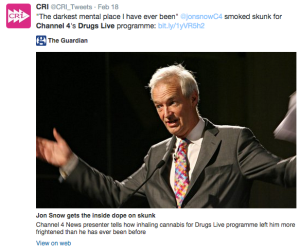 therefore the public took to slamming the drug and the effects it had on the presenter- who by the way is a man at the senior age of 67- alongside the show using the ‘frightening’ effect as a selling point of the episode to intrigue the viewer. They also use a quote from Jon himself- a respectable figure in TV that a gullible audience may be in awe of and therefore have their opinions changed by such a statement. Here is an example from Twitter:
therefore the public took to slamming the drug and the effects it had on the presenter- who by the way is a man at the senior age of 67- alongside the show using the ‘frightening’ effect as a selling point of the episode to intrigue the viewer. They also use a quote from Jon himself- a respectable figure in TV that a gullible audience may be in awe of and therefore have their opinions changed by such a statement. Here is an example from Twitter:
The programme provoked a range of ideas and responses that the theory suggests can be created. These ideas range from the preferred response; people such as the advertisers and the pictures that describe the events as ‘frightening’ and dark; the alternative response, from someone like my own mother for example who takes on board the content, and retains her own opinion alongside the one fed to her through the media; and finally there is myself, a both skeptical and open-minded person who, despite attempting to take on board the completely biased information, retains a rejective response, and disregards all negative views displayed throughout the programme.
Conclusion
To conclude, I have learnt that all of the theories exist in modern day programmes and media products around the world, and how an audience interprets a piece of information is effectively up to them. Although this fact stands, producers and creators in the media often think carefully about audience reception before creating a piece, and tailor products accordingly to create their desired response.
To quote Jim Morrison from The Doors – Whoever controls the media, controls the mind.
References:
Hypo Needle Theory – http://www.utwente.nl/cw/theorieenoverzicht/Theory%20Clusters/Mass%20Media/Hypodermic_Needle_Theory/
War of the Worlds story-
Brief History – https://www.youtube.com/watch?feature=player_embedded&v=Qt5MjBlvGcY
User and Gratifications
History quote – http://www.oxfordreference.com/view/10.1093/acref/9780199568758.001.0001/acref-9780199568758-e-1528
Background on Lazarfeld – https://en.wikipedia.org/wiki/Paul_Lazarsfeld
Reception Theory History – http://www.slideshare.net/dphillips4363/reception-theory-presentation
Stuart Hall Information – http://www.slideshare.net/robertclackmedia/audience-theory-powerpoint




